Media contact: Shannon Thomason
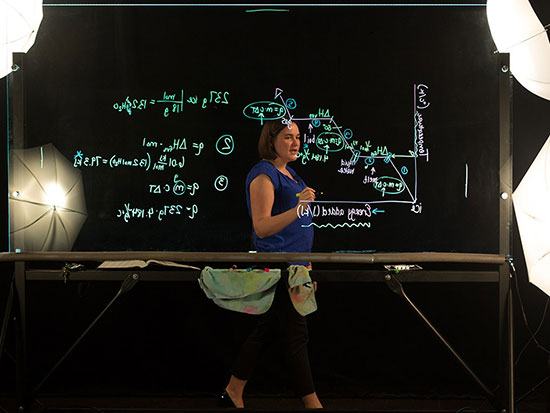 Over the past five years, enrollment in online classes at UAB has nearly doubled. In fall 2016, 10,301 students enrolled in at least one online class; 4,428 of those students were enrolled only online. The university now offers 11 online bachelor’s degrees, dozens of master’s degrees and seven doctoral and education specialist degrees.
Over the past five years, enrollment in online classes at UAB has nearly doubled. In fall 2016, 10,301 students enrolled in at least one online class; 4,428 of those students were enrolled only online. The university now offers 11 online bachelor’s degrees, dozens of master’s degrees and seven doctoral and education specialist degrees.
With more students than ever learning outside the traditional classroom environment, faculty across the university are pioneering new ways to enhance the digital education experience for undergraduates and graduate students alike.
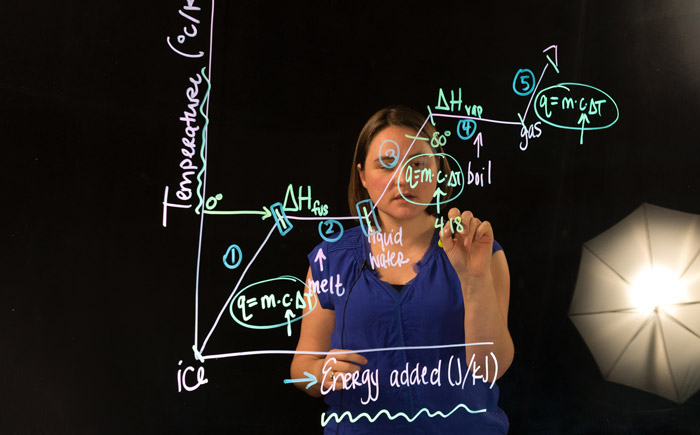 During filming, the figures that Erdmann writes on the Lightboard are reversed, so they are legible to her students. Photo by Jay Wilkins.
During filming, the figures that Erdmann writes on the Lightboard are reversed, so they are legible to her students. Photo by Jay Wilkins.
Call-in chemistry
How can you recognize an acid? Where do you assign charges to balance ionic compounds? What did I do wrong on problem 25? These are the standard kinds of questions all instructors face in introductory chemistry courses. But instructor Mitzy Erdmann, Ph.D., fields them in a unique way during office hours for her online Chemical Problem Solving (CH100) course in the UAB College of Arts and Sciences Department of Chemistry.
It’s kind of like a call-in show — for equations. Digital marker in hand, Erdmann sketches out the answers to practice problems on the Lightboard in the Digital Media Studio in UAB’s Hulsey Center. Her students, watching the broadcast live with GoToMeeting software, “can stop me and ask questions about the problem — or anything — through an earpiece I wear,” she says. Or they can type queries into a chat window, which are relayed to Erdmann by Digital Media’s Chris Humphries or Duncan McCrary.
Erdmann demonstrates how to write and name ionic compounds in this excerpt from her introductory chemistry course.
Erdmann, facing the camera, writes out chemical equations and scientific names on the Lightboard, which reverses the images so they appear legible to her online audience. “It’s a way for the students to directly interact with me in real time, even though we’re never in the same room,” she says. “It creates more of a sense of belonging to a group, and it’s fairly well documented that students perform better when online courses can create this sense of belonging.”
The Lightboard plays a major role throughout Erdmann’s CH100 course videos. “It’s easier for me to explain when I can write out problems for the students,” she says. “And they really appreciate that they can see me make the mistakes that they would make. That helps them not to make them.” In between videos, Erdmann will drop in short quizzes on the material as well. “The students like that,” she says. “They say, ‘It helps me go back and make sure I know the material.’”
Erdmann answers a student question in this excerpt from a recent "office hours" video.
Erdmann’s doctoral research focused on the use of student-created video in teaching chemistry. The results, and her example, have convinced other chemistry faculty to incorporate Lightboard videos in their classes. Professor Aaron Lucius, Ph.D., has added Lightboard videos to his 400-level Physical Chemistry I course, and Associate Professor Tracy Hamilton, Ph.D., has created a series of supplemental videos for both his classroom-based Physical Chemistry II class and his online Introductory Chemistry course for nursing students. “He liked the idea of working extra practice problems for the students beyond the limited lecture time,” Erdmann says.
“It’s very easy to use, and it’s just more fun to make videos using the Lightboard,” she adds. “I can interact with the glass and it’s like there are students in front of me. I love it.”
Answering the innovator’s dilemma
What can’t you teach online? With each semester, UAB faculty are finding new ways to bring their most requested courses to a wider array of students through online classes.
For nearly 20 years, in the U.S. and abroad, Lauren Lake has been teaching a hands-on course on sketching and inspiration. “Drawing is a way of thinking and visual problem-solving that is a path toward innovation,” says Lake, the chair of UAB’s Department of Art and Art History. “It’s a tool for creativity.”
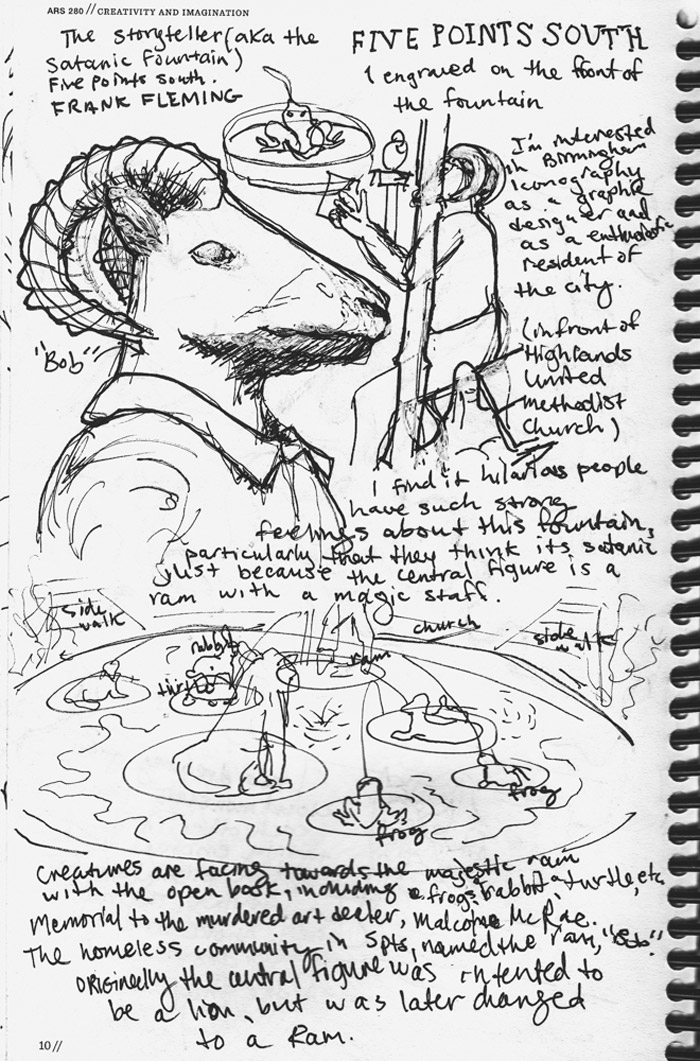 Research assignment for ARS 280: Creativity and Imagination – work by Samantha Richardson
Research assignment for ARS 280: Creativity and Imagination – work by Samantha Richardson
 Collage of student outcomes from ARS 280
Collage of student outcomes from ARS 280
Her students study the visual notation techniques that innovators and artists have used to capture their ideas, from inventor extraordinaire Thomas Edison to modern-day abstract painter Mark Bradford. They learn about mind maps, concept webs and more, then create their own versions in the sketchbooks that are the heart of the course. “The goal of this class is that when students leave, they have a sustainable tool for expression, innovation and communication, and the confidence to use that tool,” Lake says. “Whether they are in engineering, communication studies, nursing, anthropology or art, they will know how to look for ideas and play and experiment.”
An excerpt from an instructional video in Lake's Creativity and Imagination course.
Last fall, Lake drew up a new, online version of her Creativity and Imagination (ARS 280) course. Throughout the semester, students learn basic principles of drawing from Lake through demonstration videos. Then they practice these techniques using a selection of tools that are a part of the course material: two sets of sketchbooks, specially made for ARS280 through a grant to Lake from UAB’s Center for Teaching and Learning, along with a watercolor set, brushes, pens, India ink and other art supplies curated by Lake. “It’s simple enough that students can work anywhere — in their dorm room, at a kitchen table, at the library,” she says. “Having the accessibility to carry this with you makes the practice more plausible.”
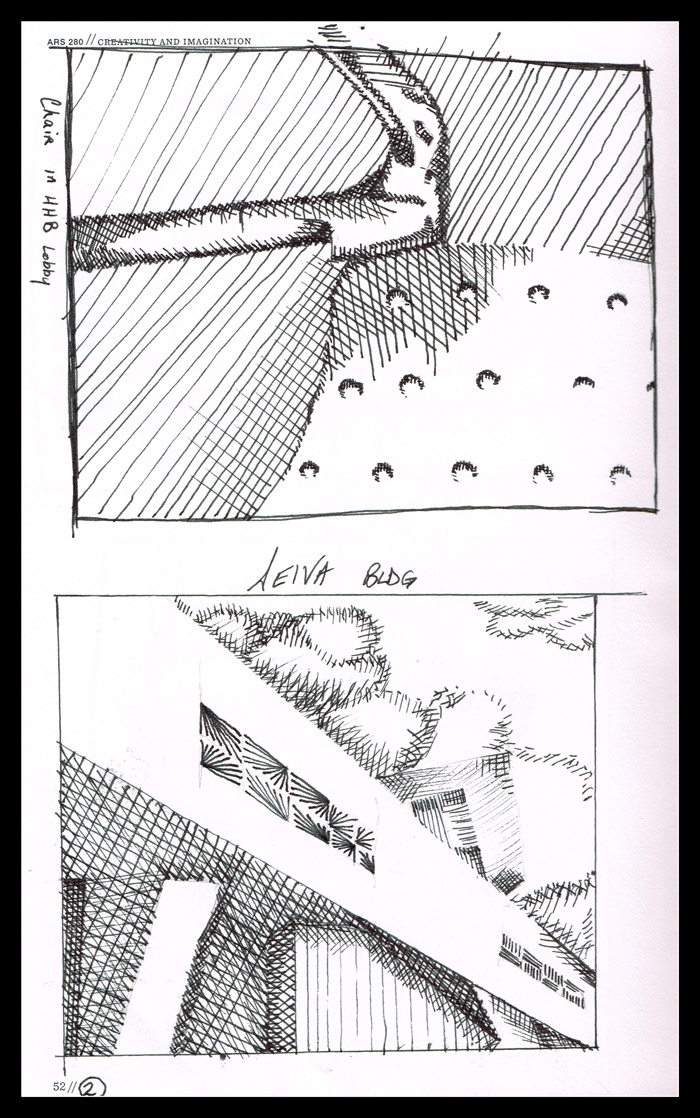 Field Sketch module – work by Anthony Smith
Field Sketch module – work by Anthony Smith
Each week, students complete a minimum of nine sketchbook pages, along with readings, viewings and listening sessions (everything from Charles Duhigg’s “The Power of Habit” to TED Talks and NPR programs). Twice a week, they snap photos of their work and “engage in discussions around the visual solutions they have uploaded” to the class discussion board, Lake says. “The act of sketching is innately kind of private. When I teach this course face-to-face, there are lots of students hovering over their books. It’s the brave soul who is the first one to put themselves out there, to post in each session. But by having to share constantly on the forum, it creates an atmosphere of trust and confidence.”
 Visual Systems module – work by Caroline Ethridge
Visual Systems module – work by Caroline Ethridge
Drawing tools are becoming increasingly common on phones and tablets, but although the class is online, the work is “100 percent analog,” Lake says. “In a time when students aren’t always taught cursive writing, a time when tablets are replacing keyboards, the act of drawing, note taking and visually solving problems involving hand-eye coordination required for drawing is very important — it brings a particular confidence. It trains visual, motor and cerebral processes to work more in sync by creating new neural pathways. The more the students draw, the more those paths stick storing a lot of new knowledge, and as a bonus, many visually stimulating outcomes are created. After all, drawing and art is first and foremost a language and form of communication.”
After so many years of teaching a version of this course in person, “to bring it to the students in this non-traditional way is really exciting,” Lake says. ARS280 was recently added to the list of courses that satisfy UAB’s Core Curriculum requirements, which makes it an option for any major. “I think that is very progressive,” Lake says. “Many artists are visionaries — they create things that never existed before, just like great scientists, engineers, and writers. They embrace experimentation, as well as collaboration and working in teams. It is our responsibility as a university to help create interdisciplinary ways to approach the problems of our time, and art is a key component to those solutions.”
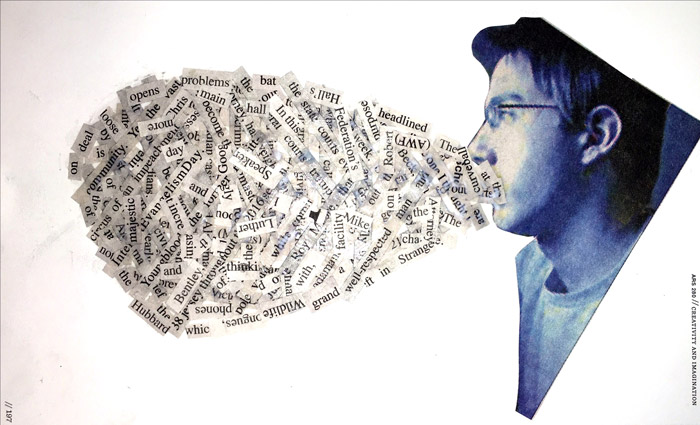 Text and Image module – work by Ryan Benson
Text and Image module – work by Ryan Benson
Clicks and consequences
One of the best parts of the popular “Choose Your Own Adventure” books of the 1980s was reading through all the possible outcomes — seeing how seemingly small variations in initial choices could lead to wildly different results. Elizabeth Kvale, M.D., medical director of the Center for Palliative and Supportive Care in the UAB School of Medicine, has adapted the concept for an online training course in acute pain management for cognitively impaired adults.
The training module, which was funded by the NIH Center of Excellence in Pain Education, is intended for medical students entering their clinical years, junior medical residents, and advance practice nursing students. The center required a video component, and Kvale knew she wanted more than a recorded lecture. She had seen a choose your own adventure-style comic book created by the U.S. military to help soldiers interact with the local population in Afghanistan, and liked the concept. But she needed help to turn the concept into a finished course.
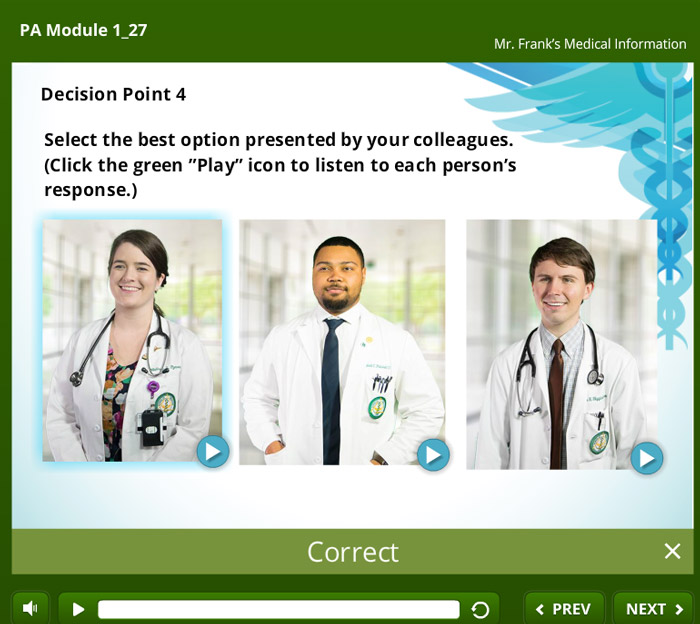 School of Medicine students played starring roles in an interactive course on pain management created by physician Elizabeth Kvale in collaboration with UAB eLearning and Professional Studies.
School of Medicine students played starring roles in an interactive course on pain management created by physician Elizabeth Kvale in collaboration with UAB eLearning and Professional Studies.
Enter Justin Moon, multimedia production manager in UAB’s Division of eLearning and Professional Studies. “The faculty are the subject matter experts,” he says. “We provide the creative side.” For the pain videos, Moon and Kvale enlisted a cast of actors, including several medical students, to play the roles of doctors, nurses and patients in a virtual hospital set created in the eLearning and Professional Studies studio. Instead of simply quizzing students on the material in the standard multiple-choice format, Kvale “wanted the learners to see the consequences of their actions all the way through,” Moon says.
Learners are asked to choose the correct dosage of pain medication to give to a particular patient, for instance. “If you choose the 25-microgram patch,” says Kvale, “you’ll see that that dose leads to respiratory suppression, which could have dire consequences for the patient.”
In the video above, highlights from several recent videos created by UAB eLearning and Professional Studies
Translating abstract concepts into the inherently visual world of online courses doesn’t always call for actors, but it does require imagination. To help an instructor demonstrate the difference between qualitative and quantitative data, Moon suggested that his team make a video of an assignment involving sorting different types of buttons that she normally demonstrates in class. For an online course in forensic investigation, Moon found a better way to film the process of collecting a fingerprint. “Instead of showing a finger rolled onto a card from above, we took a piece of glass and coated it with fluorescent dust,” he says. “Then we filmed from underneath, so the learner could see exactly what was happening.
“What educators lose in the online environment is the face-to-face connection with students,” Moon says. “How you get that back is being connected through media that gives you visual examples. We can help identify parts of a course that could be more engaging.”
“We were grateful to find on-campus expertise to support our work to create novel education strategies around acute pain management,” Kvale says. “The feedback we have received from stakeholders, editors and testers has been very positive. We are excited to evaluate whether the training will influence how students approach similar pain management situations with patients — that will be the real test of success for this work.”
Starting — and finishing — strong
UAB recently introduced three customized online pathways for different groups of students, under the direction of Deidre Murray, manager of online special programs for eLearning & Professional Studies.
Start is designed for high school juniors and seniors, who can take up to two UAB courses online, with partial scholarships available.
Salute is designed for active duty, reserve and retired military members, allowing them to use military education benefits completely online or in a blended undergraduate or graduate degree program.
Finish is designed for adults who want to return to college and complete their bachelor degree online, and includes one-on-one assistance in navigating the admissions process.
Awarding transformative courses
In 2016, UAB introduced the Provost’s Awards for Transformative Online Courses, recognizing faculty whose courses “enhance the student experience through the use of innovative teaching strategies.”
Eta Berner, Ph.D., won an award for her Introduction to Health Informatics and Health Care Delivery (HI 640) course in the School of Health Professions, which includes a role-playing simulation exercise that requires students to collaborate online in small groups.
The Principles of Accounting (AC 200) course taught by Christopher Edmonds, Ph.D., in the Collat School of Business, was selected for its innovative tree structure, which ties together videos on related concepts so that learners can quickly catch up on foundational topics if they are struggling with more advanced material.
The final award went to Malinda O’Leary, Ph.D., whose Business Spanish (SPA 313) course in the College of Arts and Sciences creates opportunities for interactive language practice, including an exercise in which students listen to one side of a phone conversation and record their responses.
Nominations for 2017 awards are open through April 1.